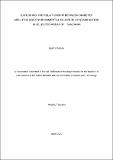| dc.contributor.author | Godson, Epafra | |
| dc.date.accessioned | 2020-11-25T11:57:32Z | |
| dc.date.available | 2020-11-25T11:57:32Z | |
| dc.date.issued | 2020-04 | |
| dc.identifier.uri | https://doi.org/10.58694/20.500.12479/1038 | |
| dc.description | A Dissertation Submitted in Partial Fulfilment of the Requirements for the Master`s in
Life Sciences of the Nelson Mandela African Institution of Science and Technology | en_US |
| dc.description.abstract | Prevalence of Diabetes Mellitus in Tanzania is on the increase. Some few studies have linked
fluoride contamination with possibilities of having effects on the insulin production resulting
to Diabetes Mellitus. This has not been fully explored in Tanzania. Therefore, this study was
undertaken to examine any relationship between fluoride levels in human blood serum and
Diabetes Mellitus status of individuals in specific two wards of Tanzania. Cross sectional
survey was conducted to explore the relationship between Diabetes Mellitus and fluoride in
human blood serum whereby, two locations with different characteristics of environmental
fluoride contamination in water sources were investigated. These areas were Ngarenanyuki
ward (fluoride endemic area) in Arusha region and Mlandizi ward (non-endemic area) in
Pwani region. The survey was conducted where 300 individuals (participants) were sampled
from the study locations and consent for fasting blood sugar levels test, whereby, 97
individuals among them consent for both fasting blood sugar test and fluoride levels in blood
serum determination. The prevalence of Diabetes Mellitus through fasting blood sugar test
was 8.3%. High Diabetes prevalence was recorded at Mlandizi ward compared to
Ngarenanyuki ward, though the difference was not significantly different (p = 0.144). Serum
fluoride > 0.0 6 mg/l was significantly high in Ngarenanyuki (79%) compared to Mlandizi
(21%) (P < 0.001). However, the current study did not establish any association between
Fasting Blood Sugar tests and fluoride levels in blood serum (Pearson`s correlation
coefficient analysis, r = - 0.0632; P < 0.663). Further work to include other cofounders is
therefore recommended in order to understand broadly the influence of fluoride in Diabetes
prevalence in fluoride endemic areas. | en_US |
| dc.language.iso | en | en_US |
| dc.publisher | NM-AIST | en_US |
| dc.rights | Attribution-NonCommercial-ShareAlike 4.0 International | * |
| dc.rights.uri | http://creativecommons.org/licenses/by-nc-sa/4.0/ | * |
| dc.subject | Research Subject Categories::NATURAL SCIENCES | en_US |
| dc.title | Exploring the relationship between diabetes mellitus and environmental fluoride contamination in selected areas of Tanzania | en_US |
| dc.type | Thesis | en_US |


